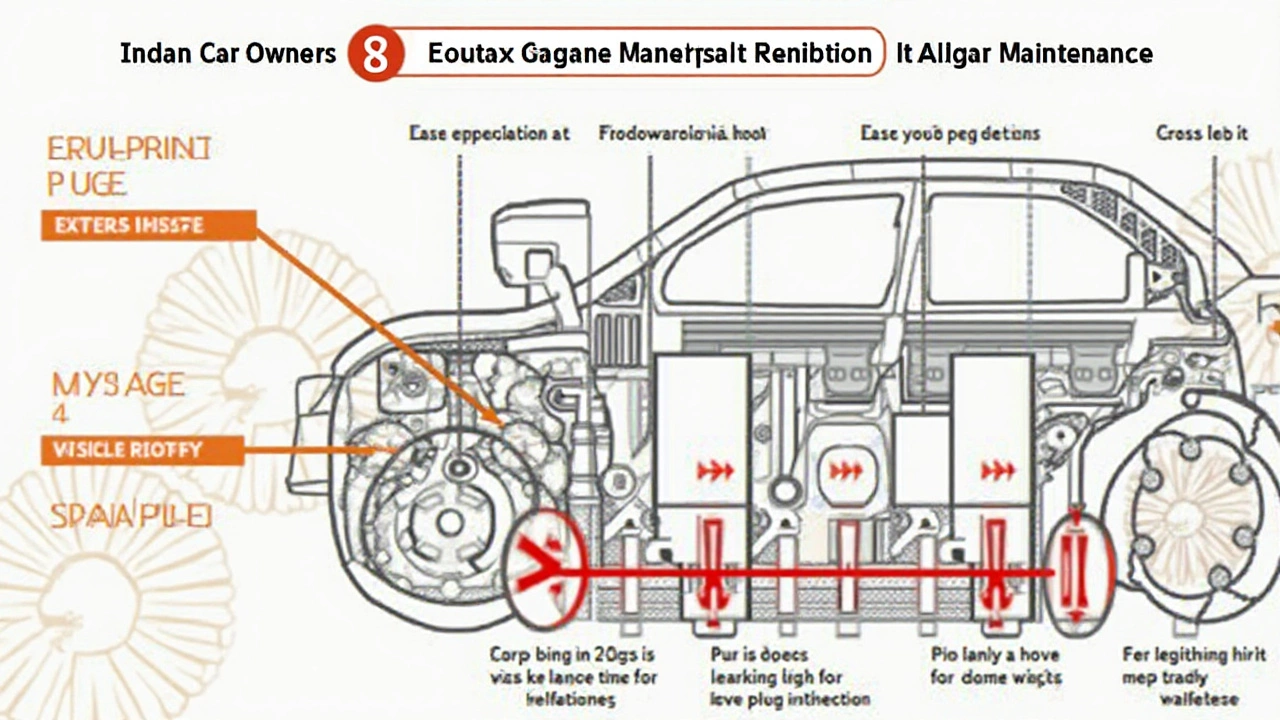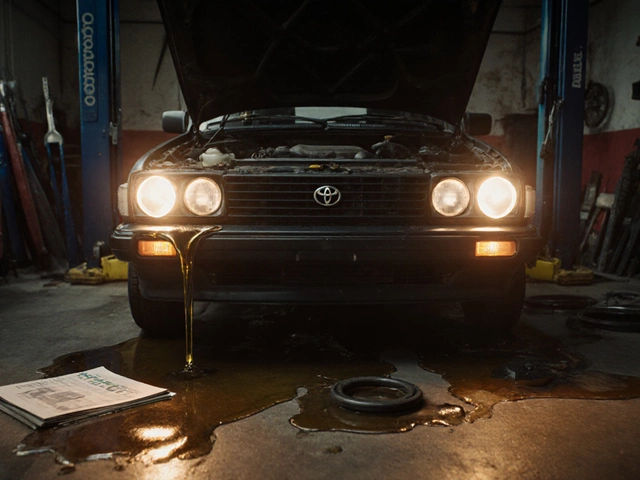In the world of automotive care, there are a few components that play a crucial role in keeping everything running smoothly and efficiently. One of these unsung heroes is the spark plug. While they might be small, spark plugs pack a powerful punch when it comes to engine performance and vehicle responsiveness.
Have you ever noticed your car feeling a little sluggish or unresponsive? It might be asking for some TLC, and it could be time to consider the condition of your spark plugs. Properly functioning spark plugs can make a world of difference in how your car performs on the road, delivering better acceleration and fuel efficiency.
Besides the potential for increased responsiveness, new spark plugs can also enhance your engine's overall longevity. Join us as we delve into the wonders of spark plug maintenance and learn how these little components can breathe new life into your ride.
- The Role of Spark Plugs in a Car's Engine
- Signs Your Car Needs a Spark Plug Change
- What Happens When Spark Plugs Wear Out
- Improving Engine Performance with New Spark Plugs
- Tips for Choosing the Right Spark Plugs
- DIY Spark Plug Replacement: What You Need to Know
The Role of Spark Plugs in a Car's Engine
Deep within the heart of your car's engine lies a tiny yet mighty component that holds the key to unleashing your vehicle's full potential: the spark plug. Often overlooked by the average car owner, these small devices are integral to the day-to-day running of your vehicle, acting as the ignition source for your engine. But how exactly do spark plugs contribute to engine performance? Let's dive into the world of spark plugs and understand their crucial role.
At its core, a spark plug is designed to ignite the air-fuel mixture in the engine's combustion chamber. When you turn the ignition key or press the start button, an electric charge is sent through the ignition system, reaching the spark plugs. Here, the spark plug produces a small but intense spark that ignites the fuel mixture, causing the engine cylinders to fire and the pistons to move. This controlled explosion is what propels your car forward. Without functioning spark plugs, the engine simply wouldn't start.
A typical engine may have anywhere from four to eight spark plugs, depending on the model and size. Each spark plug plays a pivotal role in maintaining the delicate balance of power, efficiency, and emissions. When spark plugs are in prime condition, they produce a consistent, precise spark at just the right moment — a process known as timing. Accurate timing ensures maximum power output and improved vehicle responsiveness, allowing your car to accelerate smoothly and efficiently.
Conversely, worn spark plugs can lead to a host of problems. Misfiring, sluggish acceleration, hesitation during gear shifts, and increased fuel consumption are just a few potential issues that can arise. An improperly functioning spark plug fails to ignite the air-fuel mixture fully, resulting in unburned fuel and lower engine efficiency. Over time, this can put additional strain on the engine, potentially compromising its longevity.
In the words of automotive expert Chris Fix,
"Spark plugs are the unsung heroes of the engine world. They might be small, but they have a huge impact on your car’s performance and fuel economy."
Ever wondered how spark plugs have evolved? Early spark plugs consisted of a metal core with a ceramic insulator. However, modern designs incorporate advanced materials such as platinum and iridium, which are more durable and heat-resistant, allowing them to perform better and last longer. This evolution has been driven by the need for increased efficiency and reduced emissions, key goals of today's automotive industry.
When it comes to choosing spark plugs, understanding their material composition and heat range is crucial. The heat range refers to the plug's ability to dissipate heat. Selecting plugs with the correct heat range is vital for optimal engine function. Too hot, and they can cause pre-ignition and engine damage; too cold, and they may foul more quickly. Therefore, always refer to your vehicle's manual or consult a professional for advice.
Signs Your Car Needs a Spark Plug Change
Recognizing when your car needs a spark plug change can save you a lot of hassle and ensure your vehicle is always in top shape. One of the first signs that might hint at the need for new spark plugs is a noticeable decrease in your car's performance. If your car feels sluggish, doesn't accelerate like it used to, or exhibits rough idling, it's possible the spark plugs are the culprit. These little components have a big impact on engine performance, and when they're worn out, they can't ignite the fuel-air mixture optimally.
Another telltale sign is the decrease in fuel efficiency. As spark plugs wear down, they require more energy to function, causing the engine to use more fuel in the process. If you've noticed you're making more frequent stops at the pump, it might be time to investigate your car's spark plugs. Unused fuel in the engine often results from inadequate spark, leading to a drop in mileage—a clear indication that something is amiss.
Have you been hearing unusual noises like rattling or pinging from your engine? This could be attributed to ineffective spark plugs as well. When they fail to do their job correctly, it can lead to incomplete combustion cycles, resulting in that unnerving sound. Additionally, frequent engine misfires or starting issues are common symptoms. If your car hesitates to start, but your battery is in working order, then old or damaged spark plugs might be to blame.
"Replacing your spark plugs can be a game changer for your vehicle's performance," says John Nielsen, a seasoned automotive expert from the AAA’s repair network. "Ignoring the signs can lead to more significant problems down the road."
While these signs are prevalent, always check for an illuminating check engine light on your dashboard. This light can turn on for various reasons, but worn-out spark plugs are often the underlying cause. If accompanied by any of the previously mentioned symptoms, it's a strong indicator that a spark plug check is overdue. Checking your owner's manual for the manufacturer's recommended schedule for spark plug replacement is also a wise step.
Knowing When and How Often to Check
Several factors can impact how often your spark plugs need replacing, including the type of spark plugs your car uses and your driving conditions. For instance, iridium or platinum spark plugs typically last longer than copper ones. However, consistently driving in heavy traffic or making short journeys can place extra stress on your spark plugs, requiring more frequent changes. Here’s a handy tip: if your car has reached the 30,000-kilometer milestone and you haven’t replaced the spark plugs yet, it’s a good time to start considering it.
| Type of Spark Plug | Approximate Lifespan |
|---|---|
| Copper | 20,000 - 30,000 km |
| Platinum | 60,000 - 100,000 km |
| Iridium | 100,000 - 120,000 km |
Tending to your spark plugs might seem like a small task, but its impact on your engine performance and car responsiveness cannot be overstated. By paying attention to these signs, you not only ensure your car runs smoothly but also prevent potential breakdowns, making for a more reliable and efficient ride.

What Happens When Spark Plugs Wear Out
Every car enthusiast knows there's a rhythmic symphony under the hood of their vehicle, where every part has its unique role. Among these crucial components are the spark plugs, small yet powerful devices responsible for kicking off the ignition process. Over time, like any hardworking part, spark plugs can succumb to wear and tear, causing noticeable changes in engine performance. Worn-out spark plugs struggle to perform their primary task efficiently - igniting the air-fuel mixture in the engine's combustion chamber. This inefficiency can lead to a variety of symptoms, ranging from rough idling and misfires to a significant drop in car responsiveness. Imagine trying to sprint a marathon without warming up; that's how your engine feels when operating with spent spark plugs.
It's not uncommon for the first signal of deteriorating spark plugs to be a shaking engine or unusual noises, often described as a rattling or knocking. These sounds result from incomplete combustion, as the worn spark plugs fail to produce a proper spark. This miscommunication within the engine can lead to engine misfires, where cycles of the engine's operation don't fire as they should, leaving you with a car that jolts and stammers rather than glides smoothly. More intriguing, worn spark plugs can adversely affect engine performance, and you might notice your vehicle growing thirstier, requiring more frequent fuel stops. This decline in fuel efficiency is linked directly to incomplete combustion cycles, meaning more fuel is used to cover the same distance than before. A report from the National Institute of Standards and Technology highlighted that up to 3% of fuel can be wasted due to faulty spark plugs.
If you've ever felt your vehicle hesitate when you hit the gas pedal, it could be due to aging spark plugs. The weakening of these spark plugs over time can elongate the time they take to ignite the fuel mixture. As a result, the acceleration becomes uneven or delayed, which can make overtaking or merging into traffic an unnecessarily arduous task. While these small delays might seem trivial, they contribute to the gradual decline in vehicle maintenance. Unearthing another layer to the complexity of worn spark plugs is the potential harm they pose to other engine components. For instance, the engine's oxygen sensors and catalytic converters can suffer damage due to abnormal combustion cycles, leading to expensive repairs down the line.
Recognizing when spark plugs are wearing out can save you time, money, and headache. Some experts like to remind us that preventive maintenance is key. According to a quot from esteemed mechanic and auto journalist, “A stitch in time saves nine,” meaning attending to these tiny components before significant problems surface protects the sanctity of your vehicle's health. Regular check-ups and awareness of your car's behavior help ensure you catch these issues before they escalate.
“Changing spark plugs, when needed, restores the symphony of your vehicle's engine, returning it to peak performance and providing you with that smooth driving experience you crave,” says renowned auto expert Mike Allen.
Improving Engine Performance with New Spark Plugs
Among the various maintenance tasks you can perform to enhance your car's responsiveness, changing the spark plugs stands out as one of the most impactful. When a spark plug functions optimally, it ensures a strong spark ignites the air-fuel mixture in your engine's cylinders. This precise ignition is crucial because when the mixture burns efficiently, you get more power from every drop of fuel, contributing directly to engine performance. Neglecting this important component often leads to weak ignition, resulting in misfires, reduced power, and compromised fuel economy. Therefore, a fresh set of spark plugs can be a game-changer, especially for vehicles exhibiting signs of wear and tear.
New spark plugs can improve car responsiveness because they ensure a uniform and complete burn of your air-fuel mixture. This not only boosts your vehicle's horsepower but also contributes to a smoother throttle response. Modern spark plugs are designed to withstand higher temperatures and are made with advanced materials that reduce corrosion and wear. This provides a longer lifespan and consistent performance over miles. According to the specialists at NGK, “The optimal performance of your vehicle depends on selecting the correct spark plug. Wrong plugs can lead to engine damage.” Their advice underscores the importance of choosing quality components tailored to your car's specific needs.
For those keen on pushing their engine performance to the max, upgrading to performance-oriented spark plugs could be the solution. High-performance plugs often feature iridium or platinum electrodes, offering superior durability and sparking capability. These materials are known for their resistance to wear and ability to conduct electricity more effectively, which translates to a more efficient burn. This is particularly beneficial if your car has a high-performance engine or you frequently engage in spirited driving, such as on open highways or around winding roads.
To better understand the impact of new spark plugs, here's some data on potential gains:
| Component | Average Gain (HP) |
|---|---|
| Standard Copper Plug | 0-1 |
| Platinum Plug | 1-2 |
| Iridium Plug | 2-3 |
Whether you're a daily commuter or a weekend warrior, understanding when to change your spark plugs is crucial. Consulting your vehicle's manual is always a good start, as it provides guidelines tailored to your specific make and model. Many manufacturers recommend changing spark plugs between 48,000 to 160,000 kilometers; however, if you notice reduced fuel efficiency, trouble starting, or engine surging, you might need a change sooner. For the ardent DIY-er, replacing spark plugs is a relatively straightforward task, usually requiring just a few tools and about an hour of your time.

Tips for Choosing the Right Spark Plugs
When it comes to keeping your engine performing at its best, selecting the right spark plugs is crucial. Not all spark plugs are created equal, and the choice can significantly impact your car's responsiveness and fuel efficiency. First, consider the type of spark plug material. Copper plugs tend to be more affordable but might not last very long. In contrast, platinum and iridium plugs are more durable, offering better longevity and consistent performance over time. Choosing the right material should depend on your vehicle's specifications and driving habits.
Heat range is another essential factor in spark plug selection. A plug's heat range measures its ability to dissipate heat from the combustion chamber. If your driving conditions tend to be severe, such as frequent stop-and-go traffic, you might opt for a colder plug, which handles heat better. Conversely, a hotter plug might be more suitable for high-speed, highway driving conditions where the engine runs cooler. Always refer to the vehicle manufacturer's recommendations for the ideal heat range as a starting point.
The size and fit of the spark plug must match the engine's design. Each engine requires a specific gap, diameter, and length, so precision is key. Installing a plug with incorrect dimensions can lead to poor engine performance and even potential damage. “Proper spark plugs ensure efficient combustion,” mentions Michael Johnson from MotorTrend.
Without the right fit, even the best-quality plugs can't reach their full potential.It's highly advisable to consult your vehicle's service manual or an automotive professional when in doubt.
Beyond the technical specifications, consider specialized spark plugs that are designed for specific performance needs. For example, if you have a turbocharged engine or engage in racing, high-performance spark plugs might be a smart investment to support your vehicle's unique demands. These plugs are constructed to withstand greater pressure and heat, providing additional reliability and responsiveness under demanding conditions. Investing in the right spark plugs ensures peace of mind and optimal driving experience.
Let’s not forget the brand reputation. While it might be tempting to go for the cheapest option, established brands with a good reputation for quality are generally worth the investment. Brands such as Bosch, NGK, and Denso are known for their durable and effective plugs. Sometimes, a little research into customer reviews and industry trust can go a long way in choosing dependable spark plugs that can deliver enhanced engine performance. Remember, the right spark plugs not only contribute to better fuel efficiency but also ensure your vehicle remains in top shape.
DIY Spark Plug Replacement: What You Need to Know
Tackling a DIY project in your garage can be incredibly rewarding, especially when it comes to maintaining your vehicle. Replacing spark plugs is one of those jobs that not only saves you money but also gives you a deeper understanding of how your car operates. First things first, you'll need a basic toolkit including a socket wrench, a spark plug socket, and perhaps a torque wrench if you want to be precise. Always make sure your engine is cool before you get started. Working on a hot engine isn't just uncomfortable—it can also be dangerous.
"A well-maintained car ensures safer, more reliable travels,"—says the folks at AAA, reminding us that staying on top of small maintenance tasks can prevent bigger issues down the line.
Once you've gathered your tools, pop the hood and locate the spark plug wires or ignition coils, which are usually pretty accessible, depending on your car model. You might need to refer to your vehicle's manual to find the exact location and confirm the gap setting for your new plugs. Loosening the old plugs is the next step—turn them counterclockwise with the spark plug socket until they're free. You might find that your plugs are covered in residue or oil deposits, which can indicate specific types of engine problems. Evaluating these old plugs can give you insight into your engine's overall health.
Step-by-Step Installation
Installing the new plugs is essentially the reverse process. Start by checking the gaps on the new plugs to ensure they're set correctly, using a gap gauge. Carefully insert the new plugs by hand to avoid cross-threading, turning them clockwise until finger tight, then finish with the wrench. If you have a torque wrench, use it to tighten the plugs to the manufacturer's specifications. Reattach the spark plug wires or coils, making sure they snap back securely. Keep in mind that it's crucial to handle each step with care to avoid errors that could affect your car's responsiveness.
Don't shortcut this process: take the time to double-check your work, ensuring everything is secure and in place. New spark plugs can boost engine performance and efficiency significantly, but only if installed correctly. Sitting back and starting the engine after a successful replacement is a small victory, offering smoother acceleration and fuel usage, and possibly giving your cherished vehicle a new lease on life. Once you've done it yourself, you'll likely find it easier to manage other vehicle maintenance tasks with confidence.




